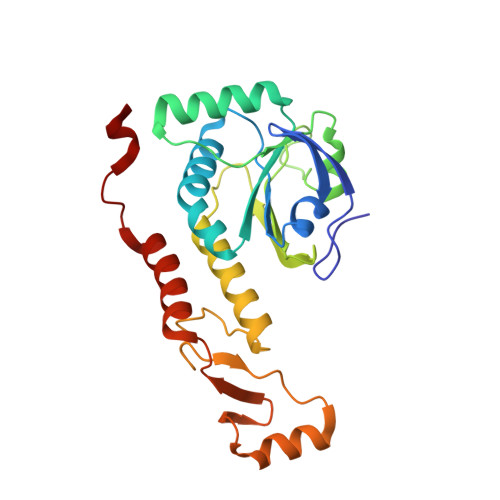Disassembly of the ring-type decameric structure of peroxiredoxin from Aeropyrum pernix K1 by amino acid mutation.
Himiyama, T., Nakamura, T.(2020) Protein Sci 29: 1138-1147
- PubMed: 32022337
- DOI: https://doi.org/10.1002/pro.3837
- Primary Citation of Related Structures:
6KRK, 6KRM, 6KRP, 6KRQ, 6KRR, 6KRS - PubMed Abstract:
The quaternary structure of peroxiredoxin from Aeropyrum pernix K1 (ApPrx) is a decamer, in which five homodimers are assembled in a pentagonal ring through hydrophobic interactions. In this study, we determined the amino acid (AA) residues of ApPrx crucial for forming the decamer using AA mutations. The ApPrx0Cys mutant, wherein all cysteine residues were mutated to serine, was prepared as a model protein to remove the influence of the redox states of the cysteines on its assembling behavior. The boundary between each homodimer of ApPrx0Cys contains characteristic aromatic AA residues forming hydrophobic interactions: F46, F80, W88, W210, and W211. We found that a single mutation of F46, F80, or W210 to alanine completely disassembled the ApPrx0Cys decamer to homodimers, which was clarified by gel-filtration chromatography and dynamic light scattering measurements. F46A, F80A, and W210A mutants lacked only one aromatic ring compared with ApPrx0Cys, indicating that the assembly is very sensitive to the surface structure of the protein. X-ray structures revealed two mechanisms of disassembly of the ApPrx decamer: loss of hydrophobicity between homodimers and flip of the arm domain. The AA residues targeted in this study are well conserved in ring-type Prx proteins, suggesting the importance of these residues in the assembly. This study demonstrates the sensitivity and modifiability of peroxiredoxin assembly by a simple AA mutation.
Organizational Affiliation:
National Institute of Advanced Industrial Science and Technology, Ikeda, Japan.















